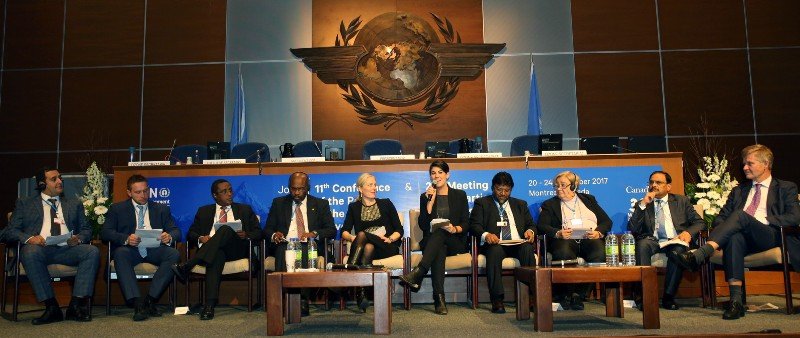How Does Change Happen? Learnings from 30 Years of the Montreal Protocol

Moderating the 30th Anniversary of the Montreal Protocol high level ministerial Round Table. Image Source
I have a very distinct memory from when I was around six years old: I was riding in the back of my friend’s mum’s car, and she told us all about the giant hole in the ozone layer and that if we didn’t fix it, we were all going to burn to death. Even at a young age, I was pretty into solving problems, so I offered suggestions. “We could all stay indoors, or hide under blankets or build a giant dome to live under!” None of these would work, she explained, because all life on Earth would be impacted. Given that this memory is etched into my brain 30 years later, it may not have been the best conversation for a kid, but its impact on me was big, and I was not the only one. It was a very important topic of the time, especially in Australia where I grew up.
In the 1970’s scientists discovered that chemicals called CFCs were released from everyday products like hair spray and the refrigerants used in air conditioners and fridges. This was also when James Lovelock was doing seminal research on the interconnectedness of planet Earth, resulting in the Gaia Theory. Despite the science still not being confirmed, the alarm bells were raised about this ozone hole and the damaging effects it would have on all humans. Increased skin cancers, cataracts, and many other illnesses were predicted based on the increase in UV rays that would enter through the holes forming around the two main poles (which is why it was such a big issue in Australia, as the hole is very big there).
The international community came together and created the Vienna Convention and then designed the Montreal Protocol, which was signed in 1987 and quickly ratified by all 197 member states on the United Nations. Now, the hole in the ozone layer is healing, and this is heralded as the most successful environmental legislation of our time.
Last week I was invited by the United Nations to host a high-level ministerial round table at the 30th Anniversary of the Montreal Protocol in Montreal Canada with eight of the world’s environment ministers and the Executive director of the UN Environment Program, Eric Solheim.
During the 90 minute session, I probed the ministers and senior government representatives on what made the Montreal Protocol so successful. I asked them to share the lessons learned and how we could apply these to other pressing environmental issues of our time. We all discussed the power of communication and innovation as mechanisms for changing the way we collectively treat the planet.
It was a great honor to be present at the 30th Anniversary of the Montreal Protocol (especially since it had such an impact on me at an early age) and to be involved in the discussion of the importance of ratifying the Kigali Amendment (which is to address the unintended consequences of the HFC’s that were used to replace CFCs; whilst they have zero impact on the ozone, they have a huge impact on climate change).
There were many points discussed during the ministerial round table. Here is a summary of the main discoveries:
The success of the Montreal protocol was related to the mechanics designed into the legislation, specifically the financial structure that had rich countries provide the financial support to not-as-wealthy countries to make the changes needed to phase out CFCs
Industries were involved from the beginning, and they supported the changes they had to make
Citizen pressure supported decision makers in their ratifying and subsequent changes needed to enact the protocol
From the start, it was based on good science; the science committee was well-funded to do the required monitoring and reporting on the ozone system
Good communication is critical to engaging the public with the issues
Global collaboration is key to successful global initiatives that require shared knowledge, technology, and policy discoveries
L-R: Khachik Hakobyan, Deputy Minister of Nature Protection, Armenia; Meelis Münt, Deputy Minister of Environment, Estonia; Vincent Biruta, Minister of Environment, Rwanda; Sydney Alexander Samuels Milson, Minister of Environment and Natural Resources, Guatemala; Catherine McKenna, Minister of Environment and Climate Change, Canada; Leyla Acaroglu, UN Environment Champion of the Earth 2016 and Moderator; Abdulla Ziyad, Minister of State, Ministry of Environment and Energy, Maldives; Zoila González de Gutíerrez, Deputy Minister of Environment, Dominican Republic; C. K. Mishra, Secretary, Ministry of Environment, Forests, and Climate Change, India; Erik Solheim, Executive Director, UN Environment
It was a great honor to be involved in this landmark meeting and to contribute to the conversation on how we can collaborate on some of the big complex systems problems we face.
I also had the great pleasure of co-presenting the Ozone Awards for the pioneers of the protocol and continued commitment to repairing our precious ozone layer.
________________________________
I am a designer, sociologist and sustainability provocateur. In 2016 I was named Champions of the Earth by the United Nations Environment program in the category of science and innovation for my work in challenging the way we understand and engage with sustainability in a global context.



